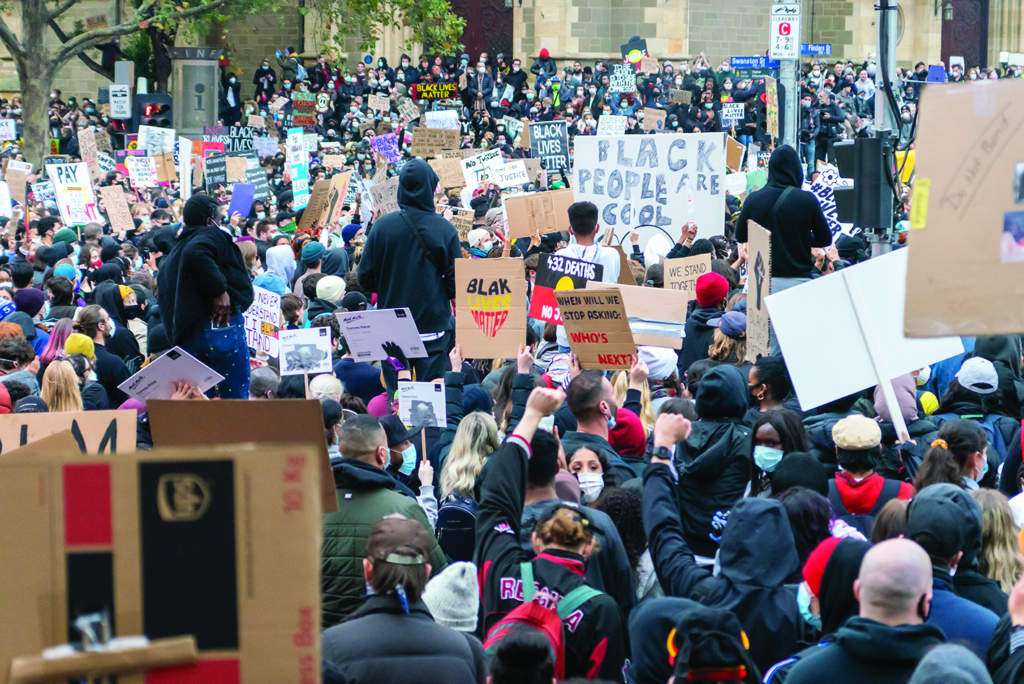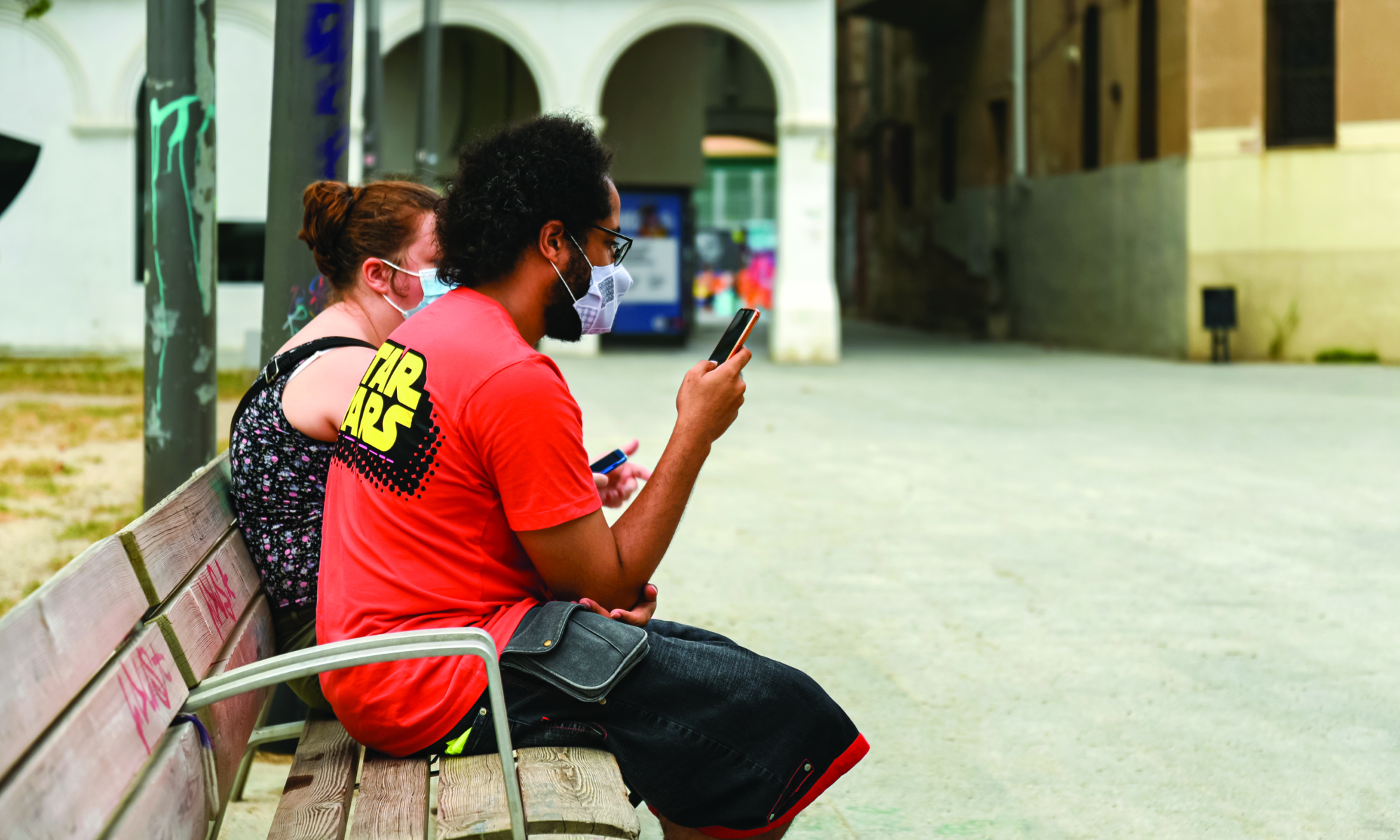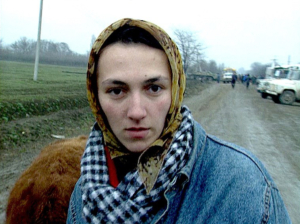The war against the COVID-19 pandemic is being fought on two fronts. On the first, the global community has suddenly found itself faced with a common enemy stealthily moving towards it or already hiding in its midst. With the virus spreading from continent to continent, various institutional bodies have marshalled their forces to contain and mitigate its effects through social distancing and digital contacting.
Modern technology thereby makes it possible to adapt to an encroaching existential threat. Makeshift working and learning environments help counter the virus’s spread with remote desktops and videoconferencing. Communication platforms such as Zoom, Webex and Microsoft Teams ensure that Australians can safely attend business meetings and virtual classrooms in their underwear or pyjama bottoms.[1]Carina Hsieh, ‘11 Zoom Confessions That’ll Have You Double-checking Your Mute Button’, Cosmopolitan, 3 April 2020, <https://www.cosmopolitan.com/sex-love/a32022911/zoom-horror-stories/>, accessed 25 August 2020. Despite restrictions on physical gatherings, socially isolated families and friends are able to stay connected and reach out to one another through electronic devices and mobile applications. The pandemic heralds the return of the previously ubiquitous work-out video, too: instead of Jane Fonda or Olivia Newton-John getting physical, gym instructors livestream yoga, pilates and aerobics classes into members’ lounge rooms from their own homes.
In many ways, COVID-19 couldn’t have come at a more fortuitous time. In contrast to the 1918–1919 Spanish flu pandemic, the anxious, bored and housebound now have Netflix,[2]Felix Arndt, ‘Netflix Has Capitalized on Social Isolation, but Will Its Success Continue in a Post-coronavirus World?’, The Conversation, 29 April 2020, <https://theconversation.com/netflix-has-capitalized-on-social-isolation-but-will-its-success-continue-in-a-post-coronavirus-world-133414>, accessed 25 August 2020. Pornhub[3]Nick Hall, ‘Pornhub Reports Massive Traffic Spike During Self-isolation Period’, Man of Many, 24 March 2020, <https://manofmany.com/lifestyle/sex-dating/pornhub-coronavirus-traffic-spike>, accessed 25 August 2020. and TikTok[4]Sherisse Pham, ‘TikTok Is Winning over Millennials and Instagram Stars as Its Popularity Explodes’, CNN Business, 5 May 2020, <https://edition.cnn.com/2020/05/05/tech/tiktok-bytedance-coronavirus-intl-hnk/index.html>, accessed 25 August 2020. to see them through. And although concerts are no longer a going concern, musical acts can now come to your home instead, with virtual tours made possible via livestreaming.[5]‘Here Are All the Livestreams & Virtual Concerts to Watch During Coronavirus Crisis (Updating)’, Billboard, updated 30 July 2020, <https://www.billboard.com/articles/columns/pop/9335531/coronavirus-quarantine-music-events-online-streams>, accessed 25 August 2020. US rapper Travis Scott broke records when millions of people were simultaneously given front-row seats to a spectacular hip-hop concert that he hosted within the videogame Fortnite.[6]Andrew Webster, ‘More than 12 Million People Attended Travis Scott’s Fortnite Concert’, The Verge, 23 April 2020, <https://www.theverge.com/2020/4/23/21233946/travis-scott-fortnite-concert-astronomical-record-breaking-player-count>, accessed 25 August 2020. While cinema-going has also been put on hold indefinitely, virtual home cinemas became increasingly viable via streaming services. Highly anticipated Australian films such as Relic (Natalie Erika James, 2020) and Hearts and Bones (Ben Lawrence, 2019) were released straight into people’s homes, and many 2020 Hollywood releases either debuted in a domestic environment or were quickly made domestically available. Consequently, increased media consumption became a part of every besieged community’s arsenal, with all demographics now having more time to kill.[7]Katie Jones, ‘How COVID-19 Has Impacted Media Consumption, by Generation’, Visual Capitalist, 7April 2020, <https://www.visualcapitalist.com/media-consumption-covid-19/>, accessed 25 August 2020. Many nations have put on a brave face, but there is still so much that remains outside of their understanding and control: How did the novel coronavirus originate? Why have transmission and mortality rates significantly varied from country to country? And will our lives ever return to normal again?

On the second front, everyone has been similarly caught off guard by the onslaught of information, conflicting reports and rampant speculation about the pandemic. As director-general of the World Health Organization (WHO) Tedros Adhanom Ghebreyesus observed, ‘We’re not just fighting an epidemic; we’re fighting an infodemic.’[8]Tedros Adhanom Ghebreyesus, ‘Munich Security Conference’, World Health Organization website, 15 February 2020, speech transcript, <https://www.who.int/dg/speeches/detail/munich-security-conference>, accessed 25 August 2020. One of WHO’s earliest daily situation reports already observed that ‘an over-abundance of information – some accurate and some not – […] makes it hard for people to find trustworthy sources and reliable guidance when they need it’.[9]World Health Organization, ‘Novel Coronavirus (2019 nCoV) Situation Report – 13’, 2 February 2020, p. 2, <https://www.who.int/docs/default-source/coronaviruse/situation-reports/20200202-sitrep-13-ncov-v3.pdf>, accessed 25 August 2020. To counter the spread of misinformation, the United Nations launched the media-literacy initiative Verified[10]See Verified website, <https://www.shareverified.com/en>, accessed 25 August 2020. and associated campaign Pause,[11]See Pause. Take Care Before You Share campaign website, <https://www.takecarebeforeyoushare.org/>, accessed 25 August 2020. while it was reported in The Guardian that Silicon Valley had also ‘responded to the “infodemic” with aggressive intervention and an embrace of official sources and traditional media outlets’.[12]Julia Carrie Wong, ‘Tech Giants Struggle to Stem “Infodemic” of False Coronavirus Claims’, The Guardian, 10April 2020, <https://www.theguardian.com/world/2020/apr/10/tech-giants-struggle-stem-infodemic-false-coronavirus-claims>, accessed 19 August 2020. Such belated tactical manoeuvres have, however, done little to combat the incidences and distribution of misinformation, as they run counter to the internet’s ecosystem – effectively closing the barn door after the horse has bolted. It’s precisely resistance to ‘official’ and ‘traditional’ information sources that has been influencing the infodemic’s mode and rate of transmission, and collective enforced retreat into virtual or alternative media environments increases susceptibility. For instance, as of late April, well over a thousand malicious COVID-19–related website domains were being created on a daily basis in an attempt to steal people’s identities or life savings.[13]Jay Chen, ‘COVID-19: Cloud Threat Landscape’, Palo Alto Networks website, 4 May 2020, <https://unit42.paloaltonetworks.com/covid-19-cloud-threat-landscape/>, accessed 25 August 2020.
The truth is out there
The pandemic and infodemic might constitute different fronts in the war, but there is one common ground on which they are being fought: their respective outbreaks are similarly occurring as social contagions (or communicative diseases). Unfortunately, media exposure is dissimilar to being exposed to a pandemic in that, for the former, there is no clear institutional interest in reducing risk or liability – national interests, commercial imperatives and personal agendas raise the question of whether it is possible to inoculate against fear, confusion and opportunism. Witness the way WHO itself got caught in the crossfire. As The Atlantic’s Kathy Gilsinan notes, the organisation found itself ‘vulnerable to misinformation and political influence’,[14]Kathy Gilsinan, ‘How China Deceived the WHO’, The Atlantic, 12 April 2020, <https://www.theatlantic.com/politics/archive/2020/04/world-health-organization-blame-pandemic-coronavirus/609820/>, accessed 21 August 2020. reporting in January that ‘the Chinese authorities have found no clear evidence of human-to-human transmission’ of COVID-19[15]World Health Organization, Twitter post dated 14 January 2020, <https://twitter.com/WHO/status/1217043229427761152>, accessed 21 August 2020. and cautioning against believing rumours to the contrary spread by frontline workers on social media.[16]See Zeynep Tufekci, ‘The WHO Shouldn’t Be a Plaything for Great Powers’, The Atlantic, 16April 2020, <https://www.theatlantic.com/health/archive/2020/04/why-world-health-organization-failed/610063/>, accessed 21 August 2020. WHO was not the only organisation that ‘decided to stick disturbingly close to official positions’ or ended up being complicit in government-friendly media’s ‘transparent cover-ups’.[17]ibid. In the United States, the Fox News network toed the (Republican) party line when it initially portrayed the pandemic as a left-wing hoax perpetrated on a gullible public by a disingenuous and alarmist media intent on bringing President Donald Trump’s administration down.[18]Ben Smith, ‘Rupert Murdoch Put His Son in Charge of Fox. It Was a Dangerous Mistake.’, The New York Times, 22 March 2020 <https://www.nytimes.com/2020/03/22/business/coronavirus-fox-news-lachlan-murdoch.html>, accessed 22 August 2020. For weeks, hosts and guests on the channel falsely reassured millions of viewers that the coronavirus posed little threat to their way of life, and encouraged Americans to ignore social-distancing recommendations. The US has, of course, gone on to have the highest infection and mortality numbers in the world[19]See Caitlin O’Kane, ‘The U.S. Has Had More Coronavirus Cases than Some Countries Have People’, CBS News, 10 August 2020, <https://www.cbsnews.com/news/coronavirus-usa-more-covid
-cases-countries-people/>, accessed 28 August 2020. – and, now that the pandemic can no longer be downplayed in mainstream news outlets, what Trump and his supporters refer to as the ‘China virus’ and ‘kung flu’[20]See Sam Clench, ‘Barack Obama Says Trump’s Use of “Kung Flu” to Describe Coronavirus “Pisses Me Off”’, News.com.au, 30 June 2020 <https://www.news.com.au/finance/work/leaders/barack-obama-says-trumps-use-of-kung-flu-to-describe-coronavirus-pisses-me-off/news-story/6b0137e524008cae8d11e851c87c953f>, accessed 22 August 2020. has been weaponised in order to keep the peace among the network’s right-wing constituency.[21]See Allyson Chiu, ‘“China Has Blood on Its Hands”: Fox News Hosts Join Trump in Blame-shifting’, The Washington Post, 19 March 2020, <https://www.washingtonpost.com/nation/2020/03/19/coronavirus-fox-news-china/>, accessed 22 August 2020. Such media exposure highlights an age-old adage: truth is the first casualty of war.
In the resulting cultural conflict, much of which has played out on social media, the patterns of transmission are thereby becoming increasingly hard to discern or isolate. Did China or the US set out to destroy the other’s economy by using COVID-19 as a biological weapon?[22]See Ian Bremmer, ‘China and America’s Blame Game over COVID-19 Hurts Everyone’, Time, 26 March 2020, <https://time.com/5810493/coronavirus-china-united-states-governments/>, accessed 26 August 2020. Is the United Nations trying to depopulate the planet for sustainability purposes?[23]See Joey D’Urso, ‘An Old Conspiracy Theory Known as “Agenda 21” Has Been Rebooted by the Coronavirus Pandemic’, BuzzFeed, 4 April 2020, <https://www.buzzfeed.com/joeydurso/coronavirus-agenda-21-5g>, accessed 26 August 2020. Are ruling elites engaged in ethnic and class cleansing?[24]See Shreya Sen-Handley, ‘Smells Like a “Cleanse”! Is It the Virus or the State?’, Deccan Chronicle, 3 May 2020, <https://www.deccanchronicle.com/opinion/columnists/030520/smells-like-a-cleanse-is-it-the-virus-or-the-state-shreya-se.html>, accessed 26 August 2020. Or are fifth-generation cellular network rollouts really to blame for all the infections and deaths?[25]See Ariel Bogle, ‘5G, Bioweapons and Distrust: Coronavirus Conspiracy Theories Are Putting Strain on Families’, ABC Science, 27 April 2020, <https://www.abc.net.au/news/science/2020-04-27/coronavirus-conspiracy-theories-tearing
-family-and-friends-apart/12177280>, accessed 26 August 2020. The pandemic has given rise to a conspiracy contagion – spreading across news cycles and social media – that shows no sign of abating anytime soon. If there is an observable thematic patterning, it is a politicisation and exploitation of the chaos that the virus has left in its wake. Despite the need for a united front, UN Secretary-General António Guterres lamented that the pandemic has unleashed a ‘tsunami of hate and xenophobia, scapegoating and scare-mongering’[26]António Guterres, quoted in Helen Davidson, ‘Global Report: Virus Has Unleashed a “Tsunami of Hate” Across World, Says UN Chief’, The Guardian, 8 May 2020, <https://www.theguardian.com/world/2020/may/08/global-report-china-open-to-cooperate-with-who-on-virus-origin-as-trump-repeats-lab-claim>, accessed 25 August 2020. intent on turning us all against one another.
Generating a vicious (news) cycle in print and electronic media, the infodemic is moving through a series of waves and wavelengths: consumption of this surfeit of information forms an inescapable, positively reinforced feedback loop. Writing in Foreign Policy,researcher Elise Thomas has observed that the infodemic feeds into ‘the preexisting dynamics of the online information ecosystem, amplifying rumors, misinformation, conspiracies, and outright lies’, untruths perpetuated by ‘the nature of social media algorithms, which are designed to optimize for engagement’,[27]Elise Thomas, ‘As the Coronavirus Spreads, Conspiracy Theories Are Going Viral Too’, Foreign Policy, 14 April 2020, <https://foreignpolicy.com/2020/04/14/as-the-coronavirus-spreads-conspiracy-theories-are-going-viral-too/>, accessed 26 August 2020. and unsatiated consumption.
More than conspiracy theories about its cause, perhaps the biggest threat to public health has been the spread of COVID-19 scepticism and/or denialism.[28]See Camron Slessor, ‘Why Do Coronavirus Sceptics and Deniers Continue to Downplay the Disease?’, ABC News, 3 May 2020, <https://www.abc.net.au/news/2020-05-03/coronavirus-sceptics-continue-to-downplay-covid19/12201344>, accessed 26 August 2020. Reports of rising infections, mounting death tolls and recurring lockdowns have seemingly done little to convince those inclined to see the pandemic as phoney or overblown; instead, the extensive media coverage has only served to somehow confirm their scepticism. We probably all know people who refuse to believe that the coronavirus threat is even real to begin with; seeing is not believing when video evidence of an unfolding pandemic is presumed to be stage-managed or doctored as a means of controlling and manipulating the populace.[29]See Valerie Strauss, ‘No, Coronavirus Is Not a “False Flag” Event or Linked to 5G Cell Towers. That and More News Literacy Lessons.’, The Washington Post, 9 April 2020, <https://www.washingtonpost.com/education/2020/04/09/no-coronavirus-is-not-false-flag-event-or-linked-5g-cell-towers-that-more-news-literacy-lessons/>, accessed 26 August 2020. Particularly alarming is how contagious this disbelief has proven to be, with various strains thereof spreading to politicians, radio hosts and laypeople alike – among the most virulent of which are the #FilmYourHospital hashtag and anti-mask protest videos. For the former, civilians are encouraged to go out and film supposedly empty hospital wards and car parks to prove that the pandemic’s official narrative is a media beat-up or false-flag event.[30]See Brandy Zadrozny & Ben Collins, ‘Coronavirus Deniers Take Aim at Hospitals as Pandemic Grows’, NBC News, 31 March 2020, <https://www.nbcnews.com/tech/social-media/coronavirus-deniers-take-aim-hospitals-pandemic-grows-n1172336>, accessed 26 August 2020. Such videos provide a counter-narrative and are presented as a way to publicly set the record straight; their message is that only ordinary people on social media are brave enough to report the truth. Amateur performers are also staging protests and walkouts in retail outlets in response to guidelines or requests for customers to wear protective masks.[31]See Dan Kois, ‘The Bad Actors’, Slate, 10 July 2020, <https://slate.com/culture/2020/07/viral-mask-freakout-videos-as-premeditated-performances.html>, accessed 26 August 2020. These viral videos both indicate participants’ membership in the resistance and act as a call to further action.
While the right to freedom of speech ensures that people can believe and share ‘truths’ as they see fit, the problems with COVID-19 scepticism cannot be ignored: a social contagion is, in part, determining the course of a biological contagion.
It would be a mistake, however, to dismiss COVID-19 denialism as just the antics of an online lunatic fringe. I can personally attest to the surprising number of people (independently) concurring offline that I’m the ‘fucking idiot’ for taking the threat of COVID-19 seriously; misinformation can travel as swiftly by word of mouth as it can through hashtags. The belief that the pandemic might be an elaborate hoax perpetuated by (or upon) the mass media is surprisingly pervasive. While the right to freedom of speech ensures that people can believe and share ‘truths’ as they see fit, the problems with COVID-19 scepticism cannot be ignored: a social contagion is, in part, determining the course of a biological contagion. As Victoria’s return to a (demoralised) state of lockdown in late June and early July indicated, people who refuse to be tested, socially distance themselves, self-isolate and/or wear masks only end up putting everyone (including themselves) at risk again. The divisive discourse surrounding the coronavirus is hardly novel, though; it acts as a reminder that competing narratives will always vie for supremacy over alternative perceptions of meaning and truth.
Sensationalism and vulnerability
If there is one take-home message from being housebound, it is a paradoxical one: that, in many ways, it’s business as usual. While life will never be the same for those who have lost loved ones and livelihoods, for many, remote working, learning and social environments have normalised an unprecedented situation by ensuring that life – to some extent – goes on. Carrying on regardless isn’t just a means of disengagement; it allows us to psychologically adapt to a new normal. Media outlets, however, are continuing to send us quite a different message: apocalypse now! Global loss of life and jobs constantly reminds us that we are not living in an unchanging world – at the time of writing, the pandemic remains a worsening crisis for billions of people. It isn’t difficult, then, to see why media outlets have reported the way they have: among other factors, fear is contagious, and over-the-top rhetoric increases commercial news providers’ bottom lines.[32]See Malcolm Sutton, ‘Sensationalist Coronavirus Reporting a “Bigger Contagion” than the Virus Itself’, ABC Radio Adelaide, 6 March 2020, <https://www.abc.net.au/news/2020-03-06/sensationalist-coronavirus-media-coverage-a-bigger-contagion/12029416>, accessed 26 August 2020. Nonetheless, alarmist stories and/or language in the press[33]See Stan Grant, ‘How Some Australian Media Are Failing Us on Coronavirus’, The Conversation, 15 April 2020, <https://theconversation.com/how-some-australian-media-are-failing-us-on-coronavirus-135550>, accessed 26 August 2020. partially explain why so many Australians suspect the pandemic of being a product of media overkill. It can be hard to believe that a catastrophic event is unfolding in real time when relatively few of us can personally testify to its direct impact.
These media bombardments appear to serve two functions: to ensure that we remain on the defensive, and to shame those who are seen to be behaving offensively. Consider the way news outlets fostered panic-buying – look at all those people stockpiling toilet paper! – and then subsequently publicly shamed panicked customers for fighting over what was left.[34]See James Purtill, ‘The Weekend’s Run on Toilet Paper Was a “Mass Psychological Event” of Triggering Images, Experts Say’, Triple J Hack, 9 March 2020, <https://www.abc.net.au/triplej/programs/hack/panic-buying-toilet-paper-a-mass-psychological-event-experts-say/12040078>, accessed 26 August 2020. We also saw media organisations violating social-distancing guidelines in bids to make sure (other) people were observing them, with camera crews running onto closed beaches and parks so as to get into people’s faces and ask: What are you doing here?
Media coverage has therefore created another paradoxical situation: we cannot isolate ourselves from the pandemic. Many of us might be safely ensconced in our homes binge-watching The Good Place or perfecting our kill/death ratios in Call of Duty,[35]See Matthew Gault, ‘I’m Gaming My Way Through Quarantine – and That’s Nothing to Feel Guilty About’, Time, 23 April 2020, <https://time.com/5824415/video-games-quarantine/>, accessed 26 August 2020. but we all remain exposed to news narratives in one way or another. Lockdown cannot prevent us from being touched by the heartbreaking reality going on outside our homes – however geographically remote many of the world’s epicentres might be. And, for many, there is no screen to act as a shield. While households experience financial and emotional strain brought about by a global health/economic crisis, another public-health emergency is rearing its ugly head around the world: increases in domestic abuse during lockdown.[36]See Amanda Taub, ‘A New Covid-19 Crisis: Domestic Abuse Rises Worldwide’, The New York Times, updated 14 April 2020, <https://www.nytimes.com/2020/04/06/world/coronavirus-domestic-violence.html>, accessed 26 August 2020. Stay-at-home safety measures not only tend to intensify feelings of insecurity, but they have also precipitated an escalation in family violence and sexual assault. COVID-19 is taking a heavy toll on mental wellbeing, too: psychologists wonder if it is possible to flatten the curves of anxiety or depression, and warn that an epidemic of mental-health problems lies ahead.[37]See Olivia Willis, ‘Mental Health Toll of Coronavirus to Create “Second Wave” of Pandemic, Experts Warn’, ABC Health & Wellbeing, 30April 2020. <https://www.abc.net.au/news/health/2020-04-30/coronavirus-mental-health-second-wave-impacts-of-pandemic/12197930>, accessed 26 August 2020.

The question, however, is whether we will be able to cope in the interim – and, well, there’s an app for that. Although mental-health interventions ideally involve building a therapeutic alliance through rapport and trust, it is now possible to apply your own treatment. Applications incorporating the therapeutic principles of cognitive behaviour therapy or acceptance and commitment therapy can be downloaded and self-administered – including apps for suicide prevention, mindfulness and meditation, substance-abuse management and mood regulation.[38]See Jessica Truschel, ‘Top 25 Mental Health Apps: An Effective Alternative for When You Can’t Afford Therapy?’, PsyCom, updated 13 August 2020, <https://www.psycom.net/25-best-mental-health-apps/>, accessed 26 August 2020.
Surveillance and division
The normalisation of our abnormal situation comes to a head with digital contact tracing. Since no vaccine is, at the time of writing, currently available – and everyone is anxious to return to their normal lives again – mobile devices have been deployed to track the virus’s trajectory and movements. Even if we fully succeed in flattening the curve, COVID-19 obviously remains an ongoing, life-threatening problem. Digital contact tracing is therefore one method of getting ahead of potential curves and cycles: following the virus as it spreads from one person to another is an attempt to stop it dead in its tracks.
Contact tracing is not a novel idea. Health researchers Edward P Richards and Katharine C Rathbun observed nearly twenty years ago that it ‘has been used for decades to control endemic contagious diseases’, and involves following up ‘anyone who might have been exposed’ to a contagion via extensive screening processes.[39]Edward P Richards III & Katharine C Rathbun, ‘The Legal Basis for Public Health’, in F Douglas Scutchfield & C William Keck (eds), Principles of Public Health Practice,Delmar Learning, New York, 2003, p. 73. Digital contact tracing, however, is new, and the novelty lies in the way potential contacts are traced: the spread of a communicative disease can now be mapped via mobile communication devices with touch screens. Digital tracing enables tracking of phone owners’ (as well as contacts’) movements through the act of communication – although it is the mobile devices themselves that are silently communicating with one another through encrypted servers. Mobile tracking devices turn normal people into virtual foot soldiers, ensuring that divisions of digital columns are moving together in single or multiple (data) files. Nonetheless, the war against the pandemic hereby carries another risk to our social wellbeing: a conflict between public-health considerations and civil liberties.
The concern is that surveillance and information gathering pose a threat to everyday social interactions: the aforementioned formation of soldiers marching in unison may unwittingly also be acting as spies. Note the way an analysis of cell-phone location data attempted to retrace COVID-19’s steps and ended up implicating the Wuhan Institute of Virology: the widely broadcast (albeit unverifiable) claim insisted that COVID-19 had begun earlier than officially reported, and that digital tracing appeared to confirm that the research laboratory had suddenly been closed in October 2019 because of a suspicious hazardous event.[40]See Ken Dilanian et al., ‘Report Says Cellphone Data Suggests October Shutdown at Wuhan Lab, but Experts Are Skeptical’, NBC News, <https://www.nbcnews.com/politics/national-security/report-says-cellphone-data-suggests%20october-shutdown-wuhan-lab-experts-n1202716>, accessed 26 August 2020. The creation of potentially exploitable and/or hackable databases therefore raises at least two ethical concerns relating to surveillance technology: social sorting and function creep.[41]See Bruce A Arrigo (ed.), The SAGE Encyclopedia of Surveillance, Security, and Privacy, SAGE Publications, London, 2016, pp. 236–8, 936–7. Segregating people into categories of ‘healthy’ and ‘sick’ – or ‘guilty’ and ‘innocent’ – risks labelling, stigmatising, scapegoating and socially isolating people indefinitely. Given COVID-19’s epidemiological characteristics, this concern is particularly acute: the pandemic is, like so many other social ills, affecting people from certain class backgrounds, races and age groups disproportionally.[42]See Grace A Noppert, ‘COVID-19 Is Hitting Black and Poor Communities the Hardest, Underscoring Fault Lines in Access and Care for Those on Margins’, The Conversation, 9 April 2020, <https://theconversation.com/covid-19-is-hitting-black-and-poor
-communities-the-hardest-underscoring-fault-lines-in-access-and-care-for-those-on-margins-135615>, accessed 26 August 2020. Function creep is when technology designed for a specific purpose invariably filters into other endeavours or purposes; in this case, an increase in surveillance could be used to keep socially sorted people in their respective places or to track people for unrelated reasons. International protests against systemic racism and police brutality set off alarm bells accordingly.[43]See Michael Baxter, ‘Opinion: Black Lives Matter Marches Demonstrate the Importance of Anonymised Decentralised Contact Tracing’, PrivSec.Report, 8 June 2020, <https://gdpr.report/news/2020/06/08/black-lives-matter-anonymised-decentralised-contact-tracing/>, accessed 25 August 2020.

While large social gatherings have raised legitimate concerns about COVID-19’s continued spread, civil libertarians are also concerned about the possibility that digital contact tracing and facial-recognition technology might be used to identify and mark protesters for social-profiling purposes.[44]See Matt Binder, ‘Officials Who Say They’re “Contact Tracing” Protesters Hurt the Fight Against COVID-19’, Mashable, 5 June 2020, <https://mashable.com/article/contact-tracing-protesters/>, accessed 26 August 2020. The intersection between public health, civic responsibility, technological advances and law enforcement has, as such, become a threat to the wellbeing of the body politic. The pandemic thus plays right into the hands of the most troubling and unrestrained aspects of digital devices: mobile phones offer the possibility of invading one another’s privacy and sowing further social discord. Technology has performed and will continue to perform a crucial role in getting us through the current crisis, and can be a vital tool for keeping people informed and safe; but COVID-19 has exposed many of the areas in which it can let us down, too. The paradox is that we may end up winning the battle against the pandemic – but losing the war to the infodemic.
Endnotes
| 1 | Carina Hsieh, ‘11 Zoom Confessions That’ll Have You Double-checking Your Mute Button’, Cosmopolitan, 3 April 2020, <https://www.cosmopolitan.com/sex-love/a32022911/zoom-horror-stories/>, accessed 25 August 2020. |
|---|---|
| 2 | Felix Arndt, ‘Netflix Has Capitalized on Social Isolation, but Will Its Success Continue in a Post-coronavirus World?’, The Conversation, 29 April 2020, <https://theconversation.com/netflix-has-capitalized-on-social-isolation-but-will-its-success-continue-in-a-post-coronavirus-world-133414>, accessed 25 August 2020. |
| 3 | Nick Hall, ‘Pornhub Reports Massive Traffic Spike During Self-isolation Period’, Man of Many, 24 March 2020, <https://manofmany.com/lifestyle/sex-dating/pornhub-coronavirus-traffic-spike>, accessed 25 August 2020. |
| 4 | Sherisse Pham, ‘TikTok Is Winning over Millennials and Instagram Stars as Its Popularity Explodes’, CNN Business, 5 May 2020, <https://edition.cnn.com/2020/05/05/tech/tiktok-bytedance-coronavirus-intl-hnk/index.html>, accessed 25 August 2020. |
| 5 | ‘Here Are All the Livestreams & Virtual Concerts to Watch During Coronavirus Crisis (Updating)’, Billboard, updated 30 July 2020, <https://www.billboard.com/articles/columns/pop/9335531/coronavirus-quarantine-music-events-online-streams>, accessed 25 August 2020. |
| 6 | Andrew Webster, ‘More than 12 Million People Attended Travis Scott’s Fortnite Concert’, The Verge, 23 April 2020, <https://www.theverge.com/2020/4/23/21233946/travis-scott-fortnite-concert-astronomical-record-breaking-player-count>, accessed 25 August 2020. |
| 7 | Katie Jones, ‘How COVID-19 Has Impacted Media Consumption, by Generation’, Visual Capitalist, 7April 2020, <https://www.visualcapitalist.com/media-consumption-covid-19/>, accessed 25 August 2020. |
| 8 | Tedros Adhanom Ghebreyesus, ‘Munich Security Conference’, World Health Organization website, 15 February 2020, speech transcript, <https://www.who.int/dg/speeches/detail/munich-security-conference>, accessed 25 August 2020. |
| 9 | World Health Organization, ‘Novel Coronavirus (2019 nCoV) Situation Report – 13’, 2 February 2020, p. 2, <https://www.who.int/docs/default-source/coronaviruse/situation-reports/20200202-sitrep-13-ncov-v3.pdf>, accessed 25 August 2020. |
| 10 | See Verified website, <https://www.shareverified.com/en>, accessed 25 August 2020. |
| 11 | See Pause. Take Care Before You Share campaign website, <https://www.takecarebeforeyoushare.org/>, accessed 25 August 2020. |
| 12 | Julia Carrie Wong, ‘Tech Giants Struggle to Stem “Infodemic” of False Coronavirus Claims’, The Guardian, 10April 2020, <https://www.theguardian.com/world/2020/apr/10/tech-giants-struggle-stem-infodemic-false-coronavirus-claims>, accessed 19 August 2020. |
| 13 | Jay Chen, ‘COVID-19: Cloud Threat Landscape’, Palo Alto Networks website, 4 May 2020, <https://unit42.paloaltonetworks.com/covid-19-cloud-threat-landscape/>, accessed 25 August 2020. |
| 14 | Kathy Gilsinan, ‘How China Deceived the WHO’, The Atlantic, 12 April 2020, <https://www.theatlantic.com/politics/archive/2020/04/world-health-organization-blame-pandemic-coronavirus/609820/>, accessed 21 August 2020. |
| 15 | World Health Organization, Twitter post dated 14 January 2020, <https://twitter.com/WHO/status/1217043229427761152>, accessed 21 August 2020. |
| 16 | See Zeynep Tufekci, ‘The WHO Shouldn’t Be a Plaything for Great Powers’, The Atlantic, 16April 2020, <https://www.theatlantic.com/health/archive/2020/04/why-world-health-organization-failed/610063/>, accessed 21 August 2020. |
| 17 | ibid. |
| 18 | Ben Smith, ‘Rupert Murdoch Put His Son in Charge of Fox. It Was a Dangerous Mistake.’, The New York Times, 22 March 2020 <https://www.nytimes.com/2020/03/22/business/coronavirus-fox-news-lachlan-murdoch.html>, accessed 22 August 2020. |
| 19 | See Caitlin O’Kane, ‘The U.S. Has Had More Coronavirus Cases than Some Countries Have People’, CBS News, 10 August 2020, <https://www.cbsnews.com/news/coronavirus-usa-more-covid -cases-countries-people/>, accessed 28 August 2020. |
| 20 | See Sam Clench, ‘Barack Obama Says Trump’s Use of “Kung Flu” to Describe Coronavirus “Pisses Me Off”’, News.com.au, 30 June 2020 <https://www.news.com.au/finance/work/leaders/barack-obama-says-trumps-use-of-kung-flu-to-describe-coronavirus-pisses-me-off/news-story/6b0137e524008cae8d11e851c87c953f>, accessed 22 August 2020. |
| 21 | See Allyson Chiu, ‘“China Has Blood on Its Hands”: Fox News Hosts Join Trump in Blame-shifting’, The Washington Post, 19 March 2020, <https://www.washingtonpost.com/nation/2020/03/19/coronavirus-fox-news-china/>, accessed 22 August 2020. |
| 22 | See Ian Bremmer, ‘China and America’s Blame Game over COVID-19 Hurts Everyone’, Time, 26 March 2020, <https://time.com/5810493/coronavirus-china-united-states-governments/>, accessed 26 August 2020. |
| 23 | See Joey D’Urso, ‘An Old Conspiracy Theory Known as “Agenda 21” Has Been Rebooted by the Coronavirus Pandemic’, BuzzFeed, 4 April 2020, <https://www.buzzfeed.com/joeydurso/coronavirus-agenda-21-5g>, accessed 26 August 2020. |
| 24 | See Shreya Sen-Handley, ‘Smells Like a “Cleanse”! Is It the Virus or the State?’, Deccan Chronicle, 3 May 2020, <https://www.deccanchronicle.com/opinion/columnists/030520/smells-like-a-cleanse-is-it-the-virus-or-the-state-shreya-se.html>, accessed 26 August 2020. |
| 25 | See Ariel Bogle, ‘5G, Bioweapons and Distrust: Coronavirus Conspiracy Theories Are Putting Strain on Families’, ABC Science, 27 April 2020, <https://www.abc.net.au/news/science/2020-04-27/coronavirus-conspiracy-theories-tearing -family-and-friends-apart/12177280>, accessed 26 August 2020. |
| 26 | António Guterres, quoted in Helen Davidson, ‘Global Report: Virus Has Unleashed a “Tsunami of Hate” Across World, Says UN Chief’, The Guardian, 8 May 2020, <https://www.theguardian.com/world/2020/may/08/global-report-china-open-to-cooperate-with-who-on-virus-origin-as-trump-repeats-lab-claim>, accessed 25 August 2020. |
| 27 | Elise Thomas, ‘As the Coronavirus Spreads, Conspiracy Theories Are Going Viral Too’, Foreign Policy, 14 April 2020, <https://foreignpolicy.com/2020/04/14/as-the-coronavirus-spreads-conspiracy-theories-are-going-viral-too/>, accessed 26 August 2020. |
| 28 | See Camron Slessor, ‘Why Do Coronavirus Sceptics and Deniers Continue to Downplay the Disease?’, ABC News, 3 May 2020, <https://www.abc.net.au/news/2020-05-03/coronavirus-sceptics-continue-to-downplay-covid19/12201344>, accessed 26 August 2020. |
| 29 | See Valerie Strauss, ‘No, Coronavirus Is Not a “False Flag” Event or Linked to 5G Cell Towers. That and More News Literacy Lessons.’, The Washington Post, 9 April 2020, <https://www.washingtonpost.com/education/2020/04/09/no-coronavirus-is-not-false-flag-event-or-linked-5g-cell-towers-that-more-news-literacy-lessons/>, accessed 26 August 2020. |
| 30 | See Brandy Zadrozny & Ben Collins, ‘Coronavirus Deniers Take Aim at Hospitals as Pandemic Grows’, NBC News, 31 March 2020, <https://www.nbcnews.com/tech/social-media/coronavirus-deniers-take-aim-hospitals-pandemic-grows-n1172336>, accessed 26 August 2020. |
| 31 | See Dan Kois, ‘The Bad Actors’, Slate, 10 July 2020, <https://slate.com/culture/2020/07/viral-mask-freakout-videos-as-premeditated-performances.html>, accessed 26 August 2020. |
| 32 | See Malcolm Sutton, ‘Sensationalist Coronavirus Reporting a “Bigger Contagion” than the Virus Itself’, ABC Radio Adelaide, 6 March 2020, <https://www.abc.net.au/news/2020-03-06/sensationalist-coronavirus-media-coverage-a-bigger-contagion/12029416>, accessed 26 August 2020. |
| 33 | See Stan Grant, ‘How Some Australian Media Are Failing Us on Coronavirus’, The Conversation, 15 April 2020, <https://theconversation.com/how-some-australian-media-are-failing-us-on-coronavirus-135550>, accessed 26 August 2020. |
| 34 | See James Purtill, ‘The Weekend’s Run on Toilet Paper Was a “Mass Psychological Event” of Triggering Images, Experts Say’, Triple J Hack, 9 March 2020, <https://www.abc.net.au/triplej/programs/hack/panic-buying-toilet-paper-a-mass-psychological-event-experts-say/12040078>, accessed 26 August 2020. |
| 35 | See Matthew Gault, ‘I’m Gaming My Way Through Quarantine – and That’s Nothing to Feel Guilty About’, Time, 23 April 2020, <https://time.com/5824415/video-games-quarantine/>, accessed 26 August 2020. |
| 36 | See Amanda Taub, ‘A New Covid-19 Crisis: Domestic Abuse Rises Worldwide’, The New York Times, updated 14 April 2020, <https://www.nytimes.com/2020/04/06/world/coronavirus-domestic-violence.html>, accessed 26 August 2020. |
| 37 | See Olivia Willis, ‘Mental Health Toll of Coronavirus to Create “Second Wave” of Pandemic, Experts Warn’, ABC Health & Wellbeing, 30April 2020. <https://www.abc.net.au/news/health/2020-04-30/coronavirus-mental-health-second-wave-impacts-of-pandemic/12197930>, accessed 26 August 2020. |
| 38 | See Jessica Truschel, ‘Top 25 Mental Health Apps: An Effective Alternative for When You Can’t Afford Therapy?’, PsyCom, updated 13 August 2020, <https://www.psycom.net/25-best-mental-health-apps/>, accessed 26 August 2020. |
| 39 | Edward P Richards III & Katharine C Rathbun, ‘The Legal Basis for Public Health’, in F Douglas Scutchfield & C William Keck (eds), Principles of Public Health Practice,Delmar Learning, New York, 2003, p. 73. |
| 40 | See Ken Dilanian et al., ‘Report Says Cellphone Data Suggests October Shutdown at Wuhan Lab, but Experts Are Skeptical’, NBC News, <https://www.nbcnews.com/politics/national-security/report-says-cellphone-data-suggests%20october-shutdown-wuhan-lab-experts-n1202716>, accessed 26 August 2020. |
| 41 | See Bruce A Arrigo (ed.), The SAGE Encyclopedia of Surveillance, Security, and Privacy, SAGE Publications, London, 2016, pp. 236–8, 936–7. |
| 42 | See Grace A Noppert, ‘COVID-19 Is Hitting Black and Poor Communities the Hardest, Underscoring Fault Lines in Access and Care for Those on Margins’, The Conversation, 9 April 2020, <https://theconversation.com/covid-19-is-hitting-black-and-poor -communities-the-hardest-underscoring-fault-lines-in-access-and-care-for-those-on-margins-135615>, accessed 26 August 2020. |
| 43 | See Michael Baxter, ‘Opinion: Black Lives Matter Marches Demonstrate the Importance of Anonymised Decentralised Contact Tracing’, PrivSec.Report, 8 June 2020, <https://gdpr.report/news/2020/06/08/black-lives-matter-anonymised-decentralised-contact-tracing/>, accessed 25 August 2020. |
| 44 | See Matt Binder, ‘Officials Who Say They’re “Contact Tracing” Protesters Hurt the Fight Against COVID-19’, Mashable, 5 June 2020, <https://mashable.com/article/contact-tracing-protesters/>, accessed 26 August 2020. |




